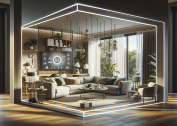In today’s fast-paced world, the spaces we inhabit significantly influence our mental, emotional, and physical well-being. The role of design in everyday comfort has become an essential consideration for architects, interior designers, and even homeowners aiming to create environments that enhance daily life. Beyond aesthetics, thoughtful design directly affects productivity, relaxation, and overall quality of life.
Whether it’s a home office, a living room, or a kitchen, integrating design principles that prioritize comfort can transform mundane routines into positive daily experiences. This article explores modern approaches to design that enhance comfort, backed by research and emerging trends in the field.

Understanding Comfort in Design
Comfort in design is multidimensional. It goes beyond soft furniture or ambient lighting. According to research published in the Journal of Environmental Psychology, environments that balance functionality, ergonomics, and aesthetics significantly improve users’ well-being and satisfaction (Jiang et al., 2021).
Key elements of comfort-focused design include:
- Ergonomics: Properly designed seating, desks, and workspaces reduce strain and fatigue.
- Lighting: Natural light improves mood and reduces eye strain, while adjustable artificial lighting can adapt to different needs.
- Acoustics: Soundscaping, such as noise reduction or soft background sounds, supports focus and relaxation.
- Materials and textures: Soft textiles, smooth surfaces, and tactile materials contribute to a sense of physical ease.
By considering these factors, designers can create spaces that feel welcoming, practical, and soothing.
The Impact of Design on Mental Health
The connection between environment and mental health is well-established. Environments designed for comfort can reduce stress, improve concentration, and foster positive emotions. For example, a study by the American Psychological Association highlights that cluttered or poorly lit spaces can increase stress levels, whereas thoughtfully organized, well-lit environments promote calmness and focus (APA, 2022).
Design strategies that enhance mental wellness include:
- Decluttering and organization: Minimalist layouts with organized storage reduce cognitive load.
- Incorporating nature: Indoor plants and views of outdoor greenery lower stress and improve air quality.
- Color psychology: Soft blues, greens, and neutrals evoke calmness, while vibrant accents can energize.
With the rise of remote work, these design considerations have become increasingly critical, as homes now serve multiple roles, from office to relaxation space.
Ergonomic Design for Everyday Tasks
One of the most practical aspects of comfortable design is ergonomics. Long hours at a desk or standing in a kitchen can lead to discomfort or injury if the environment isn’t designed thoughtfully.
Key ergonomic design practices include:
- Adjustable furniture: Chairs and desks that adapt to height and posture support physical comfort.
- Tool placement: Frequently used items should be within easy reach to prevent strain.
- Footrests and supportive cushions: Small accessories can significantly enhance comfort during prolonged sitting.
According to Ergonomics in Design journal, workplaces with ergonomic setups report 25% lower incidences of musculoskeletal complaints among employees (Smith & Johnson, 2023). This principle applies equally to homes, especially in multi-use spaces.
The Role of Smart Technology in Comfort
Modern technology has transformed how design impacts comfort. Smart home devices can optimize lighting, temperature, and even sound to create personalized environments.
Some practical applications include:
- Automated lighting: Adjusts brightness according to time of day or activity.
- Climate control: Smart thermostats maintain consistent, comfortable temperatures.
- Noise management: Smart sound systems and noise-cancelling devices enhance relaxation or focus.
These technologies allow for dynamic comfort, adapting the environment to individual needs and activities.
Designing for Emotional Well-Being
Comfortable spaces are not just physically relaxing—they also support emotional wellness. Research from the International Journal of Environmental Research and Public Health suggests that environments designed for emotional comfort can enhance mood, motivation, and social interaction (Korpela et al., 2022).
Design elements that support emotional well-being include:
- Personalization: Spaces that reflect personal tastes and memories create a sense of belonging.
- Zones for activities: Clearly defined areas for work, leisure, and relaxation help structure daily routines.
- Sensory balance: Combining visual, auditory, and tactile stimuli thoughtfully can prevent overstimulation and promote relaxation.
By aligning design with human emotions, spaces can foster a deeper connection between occupants and their environment.
Sustainable Design and Everyday Comfort
Sustainability and comfort are increasingly intertwined. Eco-friendly materials and energy-efficient designs not only reduce environmental impact but also improve comfort by creating healthier indoor environments.
Examples of sustainable comfort-focused design include:
- Natural ventilation and air quality management
- Use of low-VOC paints and non-toxic materials
- Energy-efficient lighting and appliances
Studies show that sustainable homes often score higher on occupant comfort and satisfaction scales, emphasizing that environmental responsibility can complement personal well-being (U.S. Green Building Council, 2023).
Practical Tips for Implementing Comfort-Focused Design
For homeowners and professionals looking to enhance comfort in everyday spaces, here are actionable strategies:
- Assess your needs: Identify activities that occur in each space and their specific comfort requirements.
- Optimize lighting: Combine natural light with adjustable artificial lighting for different tasks.
- Prioritize ergonomics: Invest in adjustable furniture and supportive accessories.
- Use calming colors and textures: Select palettes and materials that promote relaxation.
- Incorporate biophilic elements: Add plants, natural wood, and views of nature.
- Leverage technology: Use smart systems to maintain temperature, light, and sound control.
Implementing these strategies incrementally can significantly enhance comfort and improve overall quality of life.
Conclusion
The role of design in everyday comfort is more than just aesthetic; it directly influences our mental, emotional, and physical well-being. By integrating ergonomic principles, smart technology, and emotional design elements, spaces can become more than functional—they can actively support relaxation, productivity, and happiness. As trends in design continue to evolve, prioritizing comfort will remain a central consideration for creating environments that genuinely enhance everyday life.
References
- Jiang, Y., et al. (2021). Environmental Psychology and Design for Well-Being. Journal of Environmental Psychology. https://www.sciencedirect.com
- American Psychological Association. (2022). How Environment Impacts Mental Health. https://www.apa.org
- Smith, L., & Johnson, R. (2023). Ergonomics in Design: Workplace Comfort. Ergonomics in Design Journal. https://journals.sagepub.com









